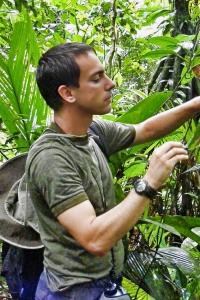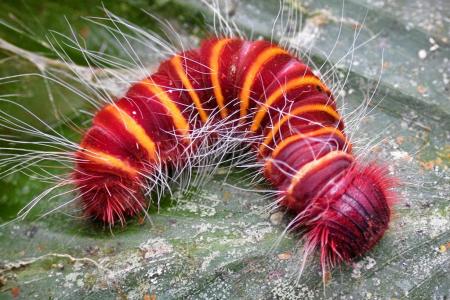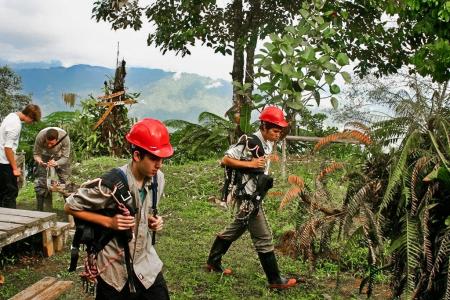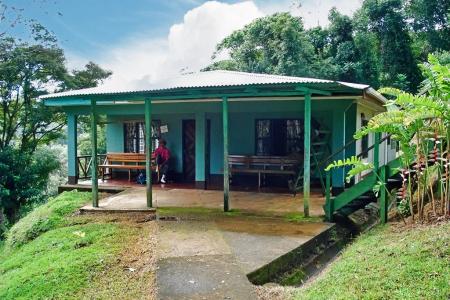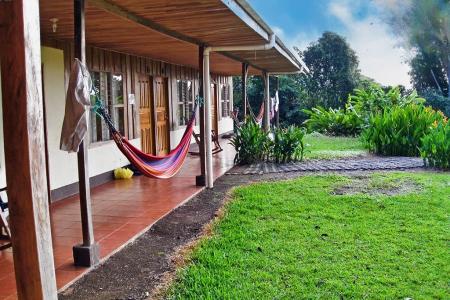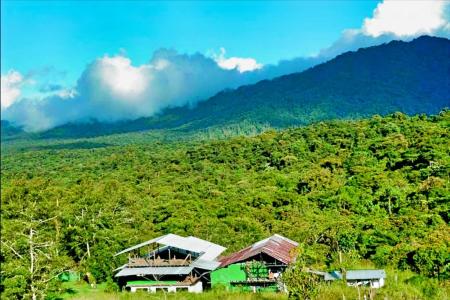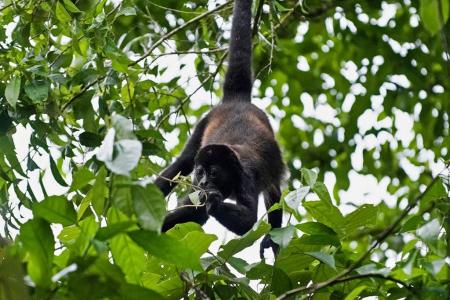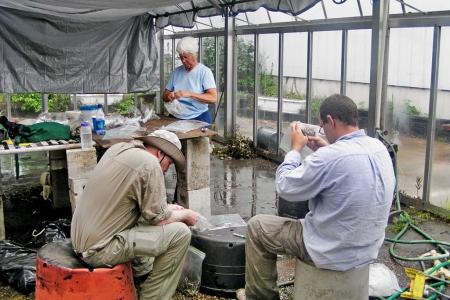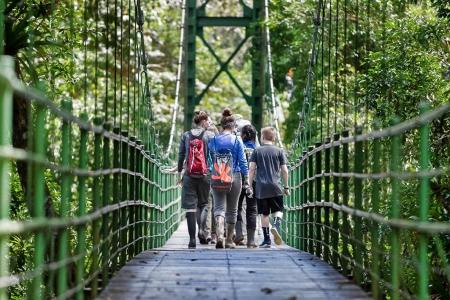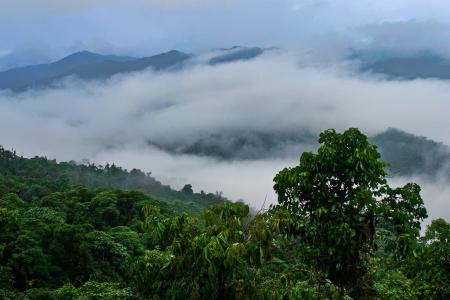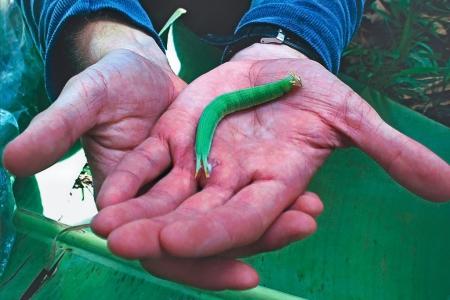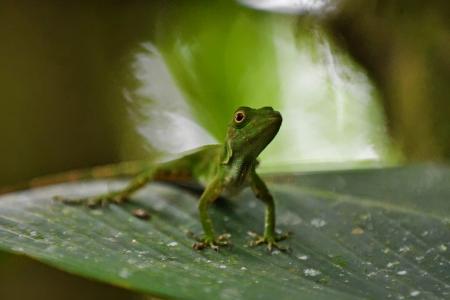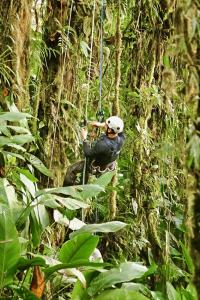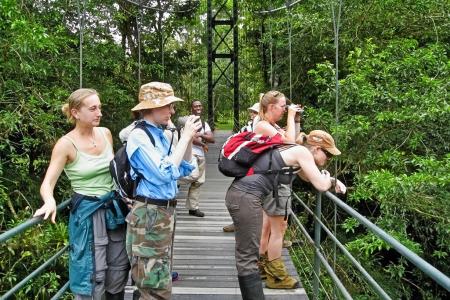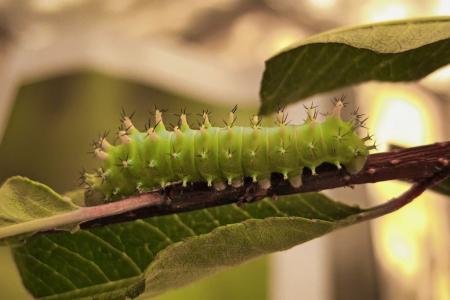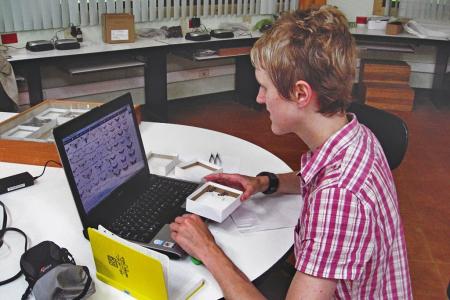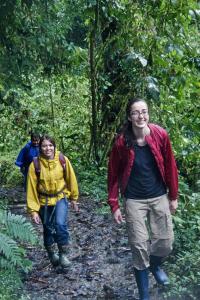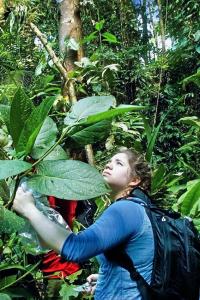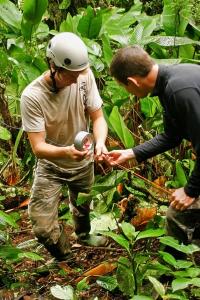Please read the following information carefully before leaving for your expedition.
Climate Change and Caterpillars
Expedition Briefing
Quick Navigation: COVID-19 Safety | The Research | Research Aims | How You Will Help | Life in the Field | Accommodations and Food | Project Conditions | Essential Eligibility Requirements | Health and Safety | Project Risks and Precautions | Travel Planning | Additional Resources
Download Packing List for Costa Rica Download Packing List for Ecuador
Click on the images to view full size!
COVID-19 Safety
You are strongly encouraged to test for COVID-19 before traveling to your expedition, particularly if you are experiencing symptoms. Do not travel if you have tested positive, and call Earthwatch right away for the next steps. Please see earthwatch.org/covid-19 for more information.
The Research
Caterpillars eat an incredible amount of plant matter—some caterpillars can eat up to 27,000 times their body weight in just a few weeks (the equivalent of a 150-pound person eating over four million pounds of food). One of the main environmental checks to this ravenous hunger is a group of insects called “parasitoids.” This group, which includes many species of wasps and flies, kills caterpillars by using them as a nursery for their larvae. Using a special organ called an ovipositor, these insects deposit their eggs either onto the backs or into the bodies of living caterpillars. This ensures a safe environment for the eggs to develop and plenty of food, as the larvae consume their host once they’ve outgrown the nursery. This relationship creates a system of checks and balances in the ecosystem: the parasitoids keep the caterpillar population from growing too large and, therefore, prevent them from overeating their host plants.
This intricate interaction involves three levels of the food chain (plants, caterpillars, and parasitoids), making it a ‘tri-trophic’ interaction. These multi-level relationships are essential to keeping many environments healthy and functioning, but increasing climatic variability is poised to disrupt these interactions. Climate-driven shifts in the timing of plant and herbivore seasonal development will likely throw off the signals that govern these relationships. Studying these types of multilevel ecosystem interactions is a new approach to understanding biodiversity and is quickly expanding our understanding of the interplay between ecosystem function, biodiversity, and climate change.
While studying the impacts of climate change on this delicate ecosystem, you will have the chance to experience fascinating and spectacular diversity—and, like many Earthwatch teams before you, you may even have the chance to encounter species new to science!
Earthwatch volunteers have assisted in this collaborative project every year since 1996, including over 1,000 volunteers aiding in long-term research [Dyer et al. 2012]. The data collected in Costa Rica and Ecuador is complemented by similar research being conducted around the world. Other Earthwatch teams on this project conduct work throughout the year in Arizona, Nevada, California, and Peru. Although interaction diversity is a new area of exploration, using information from Earthwatch projects and collaborators, we have learned that interaction diversity is particularly sensitive to climate change.
Changes in global temperatures and levels of CO2 because of climate change are likely to disrupt how ecosystem elements interact with each other. Because these changes will affect many different interactions between organisms, interaction diversity is likely to decline at a higher rate than species diversity [Stireman et al. 2005]. These changes in interaction diversity are likely to have a strong effect on ecosystem stability and function [Thompson 1996, Dyer et al. 2005]. By understanding the mechanics of the plant-caterpillar-parasitoid interaction and how climate variations alter it, we can better understand the dynamics of ecosystem interactions and how they could potentially be impacted. Staying ahead of the actual impacts is one of the best ways to be able to mitigate those impacts if and when they occur.
Parasitoids provide an essential, yet little studied, ecosystem service. By collecting natural history information and the results of long-term studies, this project will maximize the effectiveness of plant-caterpillar-parasitoid diversity databases and their analyses globally. Quantifying these relationships and collecting further data will give scientists the knowledge they need to enhance, restore, or maintain these relationships.
Climate Change and Caterpillars
Research Aims
With the help of volunteers, this project aims to understand how the regulation of caterpillars by parasitoids is affected by increases in climate variability and extreme weather events associated with climate change. This study focuses on collecting essential natural history information about host plants, caterpillars, and parasitoids to create a database of the diversity in these interactions. In addition to observational data, volunteers may assist in collecting data from long-term experiments conducted in the study area. These experiments are focused on small plots of forest, called piper plots, where researchers have specifically selected the plant community. Volunteers will record leaf abundance, spend 30 minutes searching the plants within the plot for caterpillars, and collect samples of the plants. These experiments collect data on how interaction diversity and productivity are affected by simulated effects of climate change, primarily drought. Additionally, volunteers will collect any caterpillars encountered in the study areas, as well as the host plants they were found on. This includes 38 different families of caterpillars, including a spectacular diversity of shapes, colors, and forms that function to defend against their enemies. All the caterpillars collected will be reared, and their waste will be chemically analyzed.
This project has three overarching goals:
- Continue to collect data on patterns of interaction diversity between plants, caterpillars, and associated parasitoids.
- Test specific hypotheses about how climate change parameters affect interactions, including:
- The number of interactions is lowest in areas where the number of species is lowest.
- The diversity of interactions varies with changes in environments, climate, and disturbances.
- As climate variability increases, interactions will decline more quickly than the number of species in an environment.
- The diversity of interactions affects the stability and function of an ecosystem.
- Explore plant-caterpillar-parasitoid relationships through large-scale experiments, population genomic data, natural history data, and metabolomics data
Climate Change and Caterpillars
How You Will Help
Volunteers will spend much of their time in the field, experiencing this rich diversity while working on this project. The rest of their time will be spent at the field station, aiding in rearing caterpillars and data entry. Volunteers will be involved with almost all aspects of the project. The project especially welcomes anyone with computer and web design skills. As part of this team, you will:
COLLECT AND IDENTIFY CATERPILLARS
You will spend about 70% of your time in the field, experiencing the rich diversity of Ecuador and Costa Rica. You will be trained to recognize evidence of caterpillar activity and will conduct visual searches, collecting any caterpillars encountered along with some of the plants they were found on.
COLLECT AND IDENTIFY PLANT MATERIAL
During long-term experiment data collecting, you will search plants for caterpillars in designated areas, then collect host plants, quantify leaf abundance, and collect material for laboratory or computer analyses.
PROCESS AND MONITOR CATERPILLARS
You will spend the rest of your time in the lab helping rear caterpillars. Rearing caterpillars involves placing them in clean bags, checking them for parasitoids, moving pupae to different bags, and collecting adults or parasitoids from the bag. Adult specimens are either released or preserved for further identification. Your interaction with different life stages of caterpillars and parasitoids will vary depending on their development during your time there. The station has a laboratory as well as an outdoor tent for caterpillar rearing, which has lines for hanging caterpillar bags, tables for processing and observing caterpillars, and spectacular views.
RECORD AND ENTER DATA
You will spend some time helping to enter data recorded in the field and observed in the lab by your team.
Climate Change and Caterpillars
Life in the Field
During the first two days, you will go on an orientation hike with the Earthwatch scientist or a staff member and spend time in the laboratory learning the techniques to be used. You will then practice the various jobs under staff supervision. You will also be given lectures on topics such as an introduction to caterpillars, the theory behind the project, the methods to be used, and the plan of action; natural history and ecology of parasitoids; caterpillar taxonomy; and natural products chemistry and the role of plant compounds in ecological interactions.
The team will be divided into groups, with the composition changing frequently to allow everyone to get to know each other. The tasks are varied enough that each volunteer will usually find a niche and feel satisfied with his or her contribution to the team effort.
When the team is not working, there are many activities that contribute to team development. Each evening there will be time for discussions about the progress of the research and feedback from the volunteers.
In the exciting world of ecological field and laboratory research, there is often a blurry line between work and play. Many volunteers find the “work” to be enjoyable, and some have even found it to be a life-changing experience. You will most likely experience a steep learning curve over the first few days of the project and will be pleasantly surprised at how much you have learned and accomplished by the end of the project.
ITINERARY
Weather and research needs can lead to changes in the daily schedule. We appreciate your cooperation and understanding.
COSTA RICA
- Day 1: Arrive at rendezvous hotel, introductions, and dinner.
- Day 2: Travel to La Selva Biological Station, orientation walk, evening talk followed by planning.
- Days 3–4: Training for caterpillar searching, taking care of caterpillars (“zoo”), photographing caterpillars, and measuring diversity in plots, evening talk.
- Day 5: Recreational day (these days are not fixed).
- Days 6–7: Fieldwork/Lab Work/Evening Talks.
- Day 8: Finish all projects and prepare labs for maintenance by staff.
- Day 9: Departure
ITINERARY
Weather and research needs can lead to changes in the daily schedule. We appreciate your cooperation and understanding.
ECUADOR
- Day 1: Arrival Arrive at hotel, introductions, and dinner
- Day 2: Travel to Yanayacu Biological Research Station, introductions and background orientation walk, evening talk followed by planning
- Days 3–4: Training for caterpillar searching, taking care of caterpillars (“zoo”), photographing caterpillars, and measuring diversity in plots, evening talk.
- Day 5: Recreation Day
- Days 6–7: Fieldwork/Lab Work/ Evening Talks.
- Day 8: Wrap Up Finish all studies and prepare labs for maintenance by staff, travel to Quito for dinner
- Day 9: Departure
RECREATIONAL TIME
Our research site is very remote, and recreational time will be spent at the station. Volunteers are welcome to relax around the station and surrounding forest during free time. There are many quiet places to read, write, or relax, and there are plenty of opportunities to hike, go birding, or look for other plants and animals in the cloud forest. Volunteers should find at least one other person to accompany them on any hikes that are more than one kilometer (0.6 miles) from the station and will need to inform project staff of their planned walking route. Volunteers are welcome to help with any work going on at the station if they would like.
Climate Change and Caterpillars
Accommodations and Food
* Please note that not every expedition has couples’ or singles accommodations available. Please call or email Earthwatch to check for availability prior to reserving your space(s) on the team.
COSTA RICA
SLEEPING
La Selva Biological Station: La Selva is a large and very modern research facility, and the accommodations are considered luxurious by most tropical biologists (bear in mind that a tropical biologist’s idea of luxury may not match your own!). Team members will stay in shared accommodations. Sheets and towels are provided. At La Selva, each room also has a lockable cabinet for valuables.
* Earthwatch will honor each person’s assertion of gender identity respectfully and without judgment. For both teen and adult teams, where logistics dictate single-sex accommodations or other facilities, participant placements will be made in accordance with the gender identity the participant specified on their Earthwatch Participant form and/or preferences indicated in discussions with Earthwatch.
BATHROOMS
Bathrooms at both field stations are unisex and shared. They have flush toilets and private shower stalls with changing anterooms. Showers have electric hot water heads that usually work, while the sinks have only cold water.
ELECTRICITY
All rooms have electricity at both sites. It is 120 volts, 60 hertz, and uses plugs with two flat prongs (some also have a third-round grounding pin). These are the same as U.S. outlets.
PERSONAL COMMUNICATIONS
La Selva Biological Station: Free Internet access is usually available. There are also public telephones; international phone cards can be purchased at the station’s gift shop.
The study areas usually have some cell coverage (Verizon and AT&T seem to be the best).
Please note: Personal communication with outsiders is not always possible while participating in an expedition. Earthwatch encourages volunteers to minimize outgoing calls and immerse themselves in the experience; likewise, family and friends should restrict calls to urgent messages only.
FACILITIES AND AMENITIES
La Selva Biological Station: Laundry facilities (washers and dryers) are available in the afternoons and evenings for a fee of ~$8 USD per load.
DISTANCE TO THE FIELD SITE
La Selva is a one-kilometer (0.6 miles) walk from the caterpillar lab down a paved trail through the forest. Not all volunteers will need to walk to this lab every day.
FOOD AND WATER
At La Selva, staff will cook primarily typical Latin American food. Food at both sites is varied due to the international crew of researchers. The cooks are amazing, and meals are always enjoyable and communal. For long field days, bagged lunches consist of sandwiches, fruit, juice, and cookies.
TYPICAL MEALS
The following are examples of foods you may find in the field. Variety depends on availability. We appreciate your flexibility.
- Breakfast: Beans, rice, eggs, fruit, cereal, and coffee
- Lunch and Dinner: Beans, rice, soup, potatoes, salad, meat (substitute for vegetarians), vegetables, fruit, dessert
- Snacks: Cookies, ice cream, and yogurt available for sale at La Selva
- Beverages: Water, fruit juices (beer and soft drinks available at La Selva at your own expense). Please bring a reusable personal bottle for carrying drinking water to field sites. Tap water throughout La Selva is potable.
SPECIAL DIETARY REQUIREMENTS
Please alert Earthwatch to any special dietary requirements (e.g., diabetes, lactose intolerance, nut, or other food allergies, vegetarian or vegan diets) as soon as possible, and note them in the space provided on your volunteer forms.
ECUADOR
SLEEPING
The station has dormitory-style rooms that house two to five individuals (usually of the same gender) in bunk beds. There are no guarantees that couples will have private rooms, and there are no options for single rooms. The beds are comfortable, and sheets and blankets are provided, although you will need to bring your own bath towel and hand towel and/or face cloth.
* Earthwatch will honor each person’s assertion of gender identity respectfully and without judgment. For both teen and adult teams, where logistics dictate single-sex accommodations or other facilities, participant placements will be made in accordance with the gender identity the participant specified on their Earthwatch Participant form and/or preferences indicated in discussions with Earthwatch.
BATHROOMS
Bathrooms and showers are unisex and shared. They have three flush toilets and sinks with only cold water. The two showers have gas-generated warm water and anterooms for changing.
ELECTRICITY
The station is connected to an electrical grid that is usually operational at 120 volts, but sometimes electricity is limited or fails due to natural events. All electrical equipment (e.g., digital cameras and battery chargers) can be used when electricity is available. High humidity may cause fungal growth on the lenses of cameras, and power for charging batteries is very limited.
PERSONAL COMMUNICATIONS
The Internet is available on your own devices but may experience outages for several days due to weather or technological failure.
Please note: Personal communication with outsiders is not always possible while participating in an expedition. Earthwatch encourages volunteers to minimize outgoing calls and immerse themselves in the experience; likewise, family and friends should restrict calls to urgent messages only.
FACILITIES AND AMENITIES
Laundry facilities are not available, but locals will wash clothing for a small fee; this service usually takes three to five days. Lights are usually out by 10:00 p.m. The station is small and can be noisy late at night, so earplugs can be helpful if you are a light sleeper.
DISTANCE TO THE FIELD SITE
The research station is in the middle of the project’s research area, so the study sites will typically be reached by walking. Occasionally some team members may travel to more distant sites in a project vehicle.
FOOD AND WATER
Research station staff will cook meals. Food will be varied due to the international crew of researchers; however, it will consist mainly of typical Latin American meals. Meat is usually not included, so you may want to bring supplemental snacks if you are not accustomed to a meatless diet. The cooks are excellent, and the meals are always enjoyable. Everyone eats together in a large outdoor dining room. You should bring any special food items, and you may wish to bring an insulated travel tea or coffee press for hot drinks.
TYPICAL MEALS
The following are examples of foods you may find in the field. Variety depends on availability. We appreciate your flexibility.
- Breakfast: Rice and beans, eggs, fruit, cereal, pancakes
- Lunch/Dinner: Rice and beans, soup, potatoes, salad, vegetables, fruit, dessert
- Snack: You can buy snacks and beverages at a store in the nearby town of Cosanga
- Beverages: Fruit juices, coffee, cocoa mix, beer, and soft drinks are available at your own expense
- Water: The tap water at Yanayacu is potable
SPECIAL DIETARY REQUIREMENTS
Please alert Earthwatch to any special dietary requirements (e.g., diabetes, lactose intolerance, nut, or other food allergies, vegetarian or vegan diets) as soon as possible, and note them in the space provided on your volunteer forms.
Climate Change and Caterpillars
Project Conditions
GENERAL CONDITIONS
For weather and region-specific information, please visit Wunderground.com and search for your project location.
Climate Change and Caterpillars
Essential Eligibility Requirements
All participants must be able to:
- Follow verbal and/or visual instructions independently or with the assistance of a companion.
- Take an active role in one’s own safety by recognizing and avoiding hazards if and when they arise (including, but not limited to, those described in Earthwatch materials and safety briefings). Always comply with project staff instructions and recommended safety measures.
- Be able to effectively communicate to the staff if experiencing distress or need assistance.
- Be able to get along with a variety of people from different backgrounds, often in close proximity, for the duration of the team.
- Be comfortable being surrounded by a language and/or culture that is not your own.
- Enjoy being outdoors all day in all types of weather, which may include variable temperatures, frequent rain, and high humidity.
- Carry personal daily supplies, such as lunch, water, and camera.
- Get low enough to access and collect samples on the ground and in the brush for at least one hour a day every day.
- Sit and ride, with seatbelt fastened, in a project vehicle or hired bus for up to approximately three hours per day when traveling to and from the field site. Some team members may travel to more distant sites in a project vehicle.
- Live comfortably without electricity throughout the night for the length of the project.
COSTA RICA ELIGIBILITY REQUIREMENTS:
- Walk in rubber boots over uneven, forested, mountainous terrain for two to four hours for one to three miles (1.6 to 4.8 kilometers) per day, often in high temperatures and high humidity.
- Enjoy being outdoors in the potential presence of wild animals, snakes, and insects. Spiders and snakes are ubiquitous in the forest and can also appear in laboratories and rooms
- Sit during data entry, zoo, or laboratory tasks for up to two to three hours per day for eight days.
- Live at a very active research station for the length of the project (bring earplugs to sleep comfortably if necessary).
ECUADOR ELIGIBILITY REQUIREMENTS:
- Walk in rubber boots in uneven, unstable, steep, muddy terrain carrying a light pack for up to 0.8 to eight kilometers (0.5 to five miles) per day for eight days. At times, you’ll need to hike off-trail through dense undergrowth or uphill over slippery vegetation.
- Enjoy being outdoors in the potential presence of wild animals, snakes, and insects. Spiders and snakes are ubiquitous in the forest and can also appear in laboratories and rooms.
- Tolerate living at high altitudes.
- Sit during data entry, zoo, or laboratory tasks for up to two to three hours per day for eight days.
- Tolerate heights to travel comfortably along very steep drop-offs in buses and project vehicles.
- Live at a small and sometimes very active research station for the length of the project (bring earplugs to sleep comfortably if necessary).
Climate Change and Caterpillars
Health and Safety
EMERGENCIES IN THE FIELD
Earthwatch has a 24-hour, 7-day-a-week emergency hotline number. Someone is always on call to respond to messages that come into our live answering service.
IMMUNIZATIONS & TRAVEL VACCINATIONS
Please be sure your routine immunizations are up to date (for example, diphtheria, pertussis, tetanus, polio, measles, mumps, rubella, and varicella) and that you have the appropriate vaccinations for your travel destination. Medical decisions are the responsibility of each volunteer and their doctor. Visit the Center for Disease Control and Prevention or the World Health Organization for guidance on immunizations.
If traveling from countries or regions where yellow fever is endemic, you must have a certificate of vaccination.
It is strongly encouraged that you stay up to date with your COVID-19 vaccinations, including receiving booster doses, as applicable.
Climate Change and Caterpillars
Project Risks and Precautions
COSTA RICA
TRANSPORTATION
The bus that takes volunteers from San José to La Selva travels on a wet, winding, paved mountain road that is subject to minor landslides. Participants must wear seat belts whenever they are available and may not drive project vehicles.
TERRAIN
The terrain at La Selva and Tirimbina is very hilly, and some trails are quite steep. The cement and wood trails can get very slippery, and the mud trails are sometimes difficult to navigate due to water and deep mud. Walking slowly and carefully can prevent injury. Bring appropriate footwear and remember that the hiking can be as strenuous or easy as you feel is appropriate.
ANIMALS/PLANTS
There are poisonous snakes, some irritating plants, and plenty of biting and stinging insects. Snakebites are not common at La Selva, but the use of tall rubber boots in the field and flashlights at night are necessary precautions. Insect repellent can be used to ward off mosquitoes, chiggers, biting flies, and other insects. Most of the plants are harmless to people, but there are some plants that are poisonous and can cause rashes, and these will be pointed out to the volunteers.
CHIKUNGUNYA VIRUS (CHIKV), DENGUE OR ZIKA VIRUS
These viruses are present in Costa Rica and carried by the Aedes mosquito, which is active during the daytime. Long sleeves and insect repellant should be worn to protect against bites. Participants who are pregnant should consult their doctors before traveling due to the adverse effects the Zika virus could have on the fetus.
CLIMATE/WEATHER
There will be a lot of rain, so please bring appropriate rain gear. When it is not raining, the sun will be very intense; therefore, a wide-brimmed hat, sunscreen (SPF 30 or higher), and staying well hydrated are critical.
Because of the high humidity, those persons using a hearing aid device may find it doesn’t work properly. You should consider purchasing a hearing aid dehumidifier.
PROJECT EQUIPMENT
Volunteers will use pruning clippers, which can cause injuries. You will be instructed in their proper use to minimize the risk of injury.
PERSONAL SECURITY
Some volunteers have had items stolen that they stored at the hotel or left unsecured in their rooms at the station. Please leave valuables at home where possible or properly secured while at the hotel or research site.
Take personal safety precautions while traveling both before and after the expedition. Use common sense in urban centers (San Jose) due to the risk of petty or violent crime. Avoid traveling alone and displaying money or other valuables, use caution when withdrawing money from ATMs, take taxis, and avoid traveling at night. When walking in San Jose, do not walk with a big backpack; use small bags, and consider putting your money inside your shoes. A money belt or waist pouch is also highly recommended (neck pouches are not as they can be easily spotted). It is always best practice to leave unnecessary valuables at home. Take caution in tourist areas and crowded marketplaces.
At the project site, do not wander off by yourself. It is possible to get lost, and the temperature, rainfall, and dampness can make this uncomfortable and dangerous.
DISTANCE FROM MEDICAL CARE
This project site is remote, with limited emergency response in case of medical concerns. If you are pregnant or have other conditions that could require emergency medical care, you should discuss this with your physician before joining this project.
DISEASES
All volunteers should see a travel doctor before leaving to discuss immunizations and other precautions to take against tropical diseases.
RISK OF COVID-19 OR OTHER RESPIRATORY ILLNESS
Earthwatch strongly encourages you to take precautions to help protect yourself and others from common viral respiratory illnesses, including COVID-19, flu, and RSV: stay up to date with your vaccinations; wash your hands frequently; take steps to improve air quality, for example, by increasing ventilation indoors or gathering outdoors; and use preventative measures to limit the spread if you are sick.
Persons with a higher risk of severe respiratory illness should consult their healthcare provider before participating.
ECUADOR
TRANSPORTATION
The road system in Ecuador can be risky by Western standards due to fast and reckless drivers, rain, poor or no lighting, and poor road conditions. The bus ride from Quito to Yanayacu takes a wet, winding mountain road that is very steep in sections, has long unpaved sections, and is frequently subject to landslides. Driving at night will be avoided. Seat belt use is required whenever possible. Volunteers are not permitted to drive.
TERRAIN
The trails where volunteers will collect caterpillars are steep, muddy, and slippery. Wear appropriate footwear (hiking boots with ankle support or Wellington boots with good tread; see the packing checklist). Always walk slowly and carefully, be aware of your surroundings, and heed staff instructions. Hiking can be as strenuous or easy as you feel is appropriate since caterpillars can be found everywhere.
ALTITUDE SICKNESS
Different people react in different ways to working at high altitudes. Even people who are very fit at sea level can find themselves struggling as they walk at higher altitudes. Take the first few days slowly (project staff will provide activities that require less exertion at the beginning of the expedition), and report any illness (headache, lethargy, appetite loss, nausea, etc.) to staff immediately. Also, remain well hydrated. The sun is strong at these altitudes, so a high-factor sunscreen and protective clothing (wide-brimmed hat, sunglasses, and long sleeves) are essential. If you have any condition that might be affected by increased sun exposure or if you are sensitive to heat, please consult a physician. Many common prescription medications can increase your sensitivity to sun and heat. Illnesses that may be aggravated by altitude include sickle cell anemia and chronic heart and lung diseases. Those with asthma or other breathing problems may experience altitude-related discomfort and may wish to consult with their doctors in advance.
ANIMALS/PLANTS
There are no large, dangerous animals or poisonous snakes in the area. There are few biting and stinging insects, but some visitors choose to bring insect repellent to ward off the occasional mosquito. Anyone allergic to wasps, bees, or ant stings should bring medications as appropriate with them (e.g., at least two Epi-Pens).
CHIKUNGUNYA VIRUS (CHIKV), DENGUE OR ZIKA VIRUS
These viruses are present in Ecuador and carried by the Aedes mosquito, which is active during the daytime. The mosquitos that carry the Chikungunya and malaria viruses do not reside in the cloud forest where Yanayacu is. They are found in the lowlands, like on the beach. Nonetheless, long sleeves and insect repellant should be worn to protect against bites. Volunteers should ask their doctors about preventative medicine for Malaria based on their travel plans. Participants who are pregnant should consult their doctors before traveling due to the adverse effects the Zika virus could have on the fetus.
CLIMATE/WEATHER
Due to the altitude, the climate, and the demanding nature of the research activities, take care to avoid dehydration. Always carry and drink plenty of water throughout the day and get enough to eat. Do not overexert yourself. Inform a staff member right away if you feel tired or ill. There will be a lot of rain, so bring appropriate gear. The risk of sunburn is also high; bring a wide-brimmed hat, sunscreen (30 SPF or higher), and appropriate clothing. Because of the high humidity, people who use hearing aids may find that they don’t work properly. You should consider purchasing a hearing aid dehumidifier.
PROJECT TASKS/EQUIPMENT
Volunteers will use pruning clippers. You will be instructed in their proper use to minimize the risk of injury.
POLITICAL
Roads are sometimes closed due to protests in the area. These protests do not generally pose a risk but should be avoided wherever possible.
PERSONAL SECURITY
Take personal safety precautions while traveling both before and after the expedition. Use common sense in urban centers (Quito, Tena, Guayaquil) due to the risk of petty or violent crime. Avoid traveling alone and displaying money or other valuables, use caution when withdrawing money from ATMs, take taxis, and avoid traveling at night. When walking in Quito, do not walk with a big backpack; use small bags, and consider putting your money inside your shoe. A money belt or waist pouch is also highly recommended (neck pouches are not as they can be easily spotted). It is always best practice to leave unnecessary valuables at home. Take caution in tourist areas and crowded marketplaces. In Quito, in particular, the old city center, city parks, Virgin of the Panecillo (El Panecillo) shrine, Calle Morales (often referred to as Calle La Ronda), El Tejar, Parroquia San Sebastiçn (old city), Gonzalez Suarez (old city), Avenida Cristùbal Colùn (new city), and the districts of La Mariscal, La Carolina, La Floresta, and La Marin should be avoided at night due to the high risk of petty crime. Also, avoid hiking in the areas surrounding Volcan Pichincha and the Teleferico (cable car). At the project site, do not wander off by yourself. It is possible to get lost, and the temperature, rainfall, and dampness can make this uncomfortable and dangerous.
DISEASES
All volunteers should see a travel doctor before leaving to discuss immunizations and other precautions to take against tropical diseases.
RISK OF COVID-19 OR OTHER RESPIRATORY ILLNESS
Earthwatch strongly encourages you to take precautions to help protect yourself and others from common viral respiratory illnesses, including COVID-19, flu, and RSV: stay up to date with your vaccinations; wash your hands frequently; take steps to improve air quality, for example, by increasing ventilation indoors or gathering outdoors; and use preventative measures to limit the spread if you are sick.
Persons with a higher risk of severe respiratory illness should consult their healthcare provider before participating.
Climate Change and Caterpillars
Travel Planning
RENDEZVOUS LOCATION
COSTA RICA
Lobby of the DoubleTree by Hilton Hotel, San Jose, Costa Rica
ECUADOR
EB Hotel, Tababela, Pichincha 170907 Ecuador
* Additional information will be provided by Earthwatch to meet your team. Please do not book travel arrangements such as flights until you have received additional information from Earthwatch.
ABOUT YOUR DESTINATION
Earthwatch strongly recommends that travelers investigate their destination prior to departure. Familiarity with the destination’s entry/exit requirements, visas, local laws, and customs can go a long way to ensuring smooth travel. The U.S. Department of State's Traveler’s Checklist and Destination Guides are helpful resources. For LGBTI travelers, the U.S. Department of State's LGBTI Travelers page contains many useful tips and links.
COUNTRY AND PROJECT ENTRY REQUIREMENTS
You are responsible for reviewing and abiding by your destination's entry/exit requirements.
Entry visa requirements differ by country of origin, layover, and destination and do change unexpectedly. For this reason, please confirm your visa requirements at the time of booking and again 90 days before travel. Please apply early for your visa (we recommend starting six months before the start of your expedition). Refunds will not be made for volunteers canceling due to not obtaining their visa in time to meet the team at the rendezvous. You can find up-to-date visa requirements at the following website: travisa.com.
If a visa is required, participants should apply for a TOURIST visa. Please note that obtaining a visa can take weeks or even months. We strongly recommend using a visa agency to expedite and simplify the process.
Climate Change and Caterpillars
Resources
BOOKS
- Wagner, D.L., 2010. Caterpillars of eastern North America: a guide to identification and natural history. Princeton University Press.
ARTICLES
- The first article is highly recommended. Link to these papers: wolfweb.unr.edu/~ldyer/papers.htm
- Dyer, L.A., Wagner, D.L., Greeney, H.F., Smilanich, A.M., Massad, T.M., Robinson, M. Fox, M., Hazen, R., Glassmire, A., Pardikes, N., Fredrickson, K., Pearson, C., Gentry, G.L., and J.O. Stireman III. 2012. Novel insights into tritrophic interaction diversity and chemical ecology using 16 years of volunteer supported research. American Entomologist 58:15-19.
- Stireman, J.O. III, L.A. Dyer, D.H. Janzen, M.S. Singer, J.T. Lill, R.J. Marquis, R.E. Ricklefs, G.L. Gentry, W. Hallwachs, P.D. Coley, J.A. Barone, H.F. Greeney, H. Connahs, P. Barbosa, H.C. Morais, and I.R. Diniz. 2005. Climatic unpredictability and parasitism of caterpillars: Implications of global warming. Proceedings of the National Academy of Sciences 102:17384-17387.
PROJECT-RELATED WEBSITES
LITERATURE CITED
- Dyer, L.A., M.S. Singer, J.T. Lill, J.O. Stireman III, G.L. Gentry, R.J. Marquis, R.E. Ricklefs, H.F. Greeney, D.L. Wagner, H.C. Morais, I.R. Diniz, T.A. Kursar, and P.D. Coley. 2007. Host specificity of Lepidoptera in tropical and temperate forests. Nature 448:696-699.
- Dyer, L.A., T.R. Walla, H.F. Greeney, J.O. Stireman III, and R.F. Hazen. 2010. Diversity of interactions: A metric for studies of biodiversity. Biotropica 42:281-289.
- Dyer, L.A., and D.K. Letourneau. 2013. Can Climate Change Trigger Massive Diversity Cascades in Terrestrial Ecosystems? Diversity 5:1-35.
- Forister, M. L., Novotny, V., Panorska, A. K., Baje, L., Basset, Y., Butterill, P. T., Cizek, L., Coley, P. D., Dem, F., Diniz, I. R., Drozd, P., Fox, M., Glassmire, A., Hazen, R., Hrcek, J., Jahner, J. P., Kama, O., Kozubowski, T. J., Kursar, T. A., Lewis, O. T., Lill, J., Marquis, R. J., Miller, S. E., Morais, H. C., Murakami, M., Nickel, H., Pardikes, N., Ricklefs, R. E., Singer, M. S., Smilanich, A. M., Stireman, J. O., Villamarín-Cortez, S., Vodka, S., Volf, M., Wagner, D. L., Walla, T., Weiblen, G. D., and L. A. Dyer. 2015. Global distribution of diet breadth in insect herbivores. Proceedings of the National Academy of Sciences 112:442-447.
- Glassmire, A. E., Jeffrey, C. S., Forister, M. L., Parchman, T. L., Nice, C. C., Jahner, J. P., Wilson, J. S., Walla, T. R., Richards, L. A., Smilanich, A. M., Leonard, M. D., Morrison, C. R., Simbaña, W., Salagaje, L. A., Dodson, C. D., Miller, J. S., Tepe, E. J., Villamarin-Cortez, S. and Dyer, L. A. (2016), Intraspecific phytochemical variation shapes community and population structure for specialist caterpillars. New Phytologist 212:208-219.
- Long, Z. T., J. F. Bruno, and J. E. Duffy. 2007. Biodiversity mediates productivity through different mechanisms at adjacent trophic levels. Ecology 88: 2821-2829.
- McCann, K. S. 2000. The diversity-stability debate. Nature 405:228-233.
- Rodríguez-Castañeda, H.G. Connahs, T.R. Walla and L.A. Dyer. 2010. Tropical forests are not flat: How mountains affect herbivore diversity. Ecology Letters (in prep).
- Smilanich, A.M., L.A. Dyer, and G. L. Gentry. 2009. The insect immune response and other putative defenses as effective predictors of parasitism. Ecology 90:1434-1440.
- Stireman, J.O. III, L.A. Dyer, D.H. Janzen, M.S. Singer, J.T. Lill, R.J. Marquis, R.E. Ricklefs, G.L. Gentry, W. Hallwachs, P.D. Coley, J.A. Barone, H.F. Greeney, H. Connahs, P. Barbosa, H.C. Morais, and I.R. Diniz. 2005. Climatic unpredictability and parasitism of caterpillars: Implications of global warming. Proceedings of the National Academy of Sciences 102:17384-17387.
Climate Change and Caterpillars
Sign up for the Earthwatch Newsletter
Be the first to know about new expeditions, stories from the field, and exciting Earthwatch news.
.
.
.

